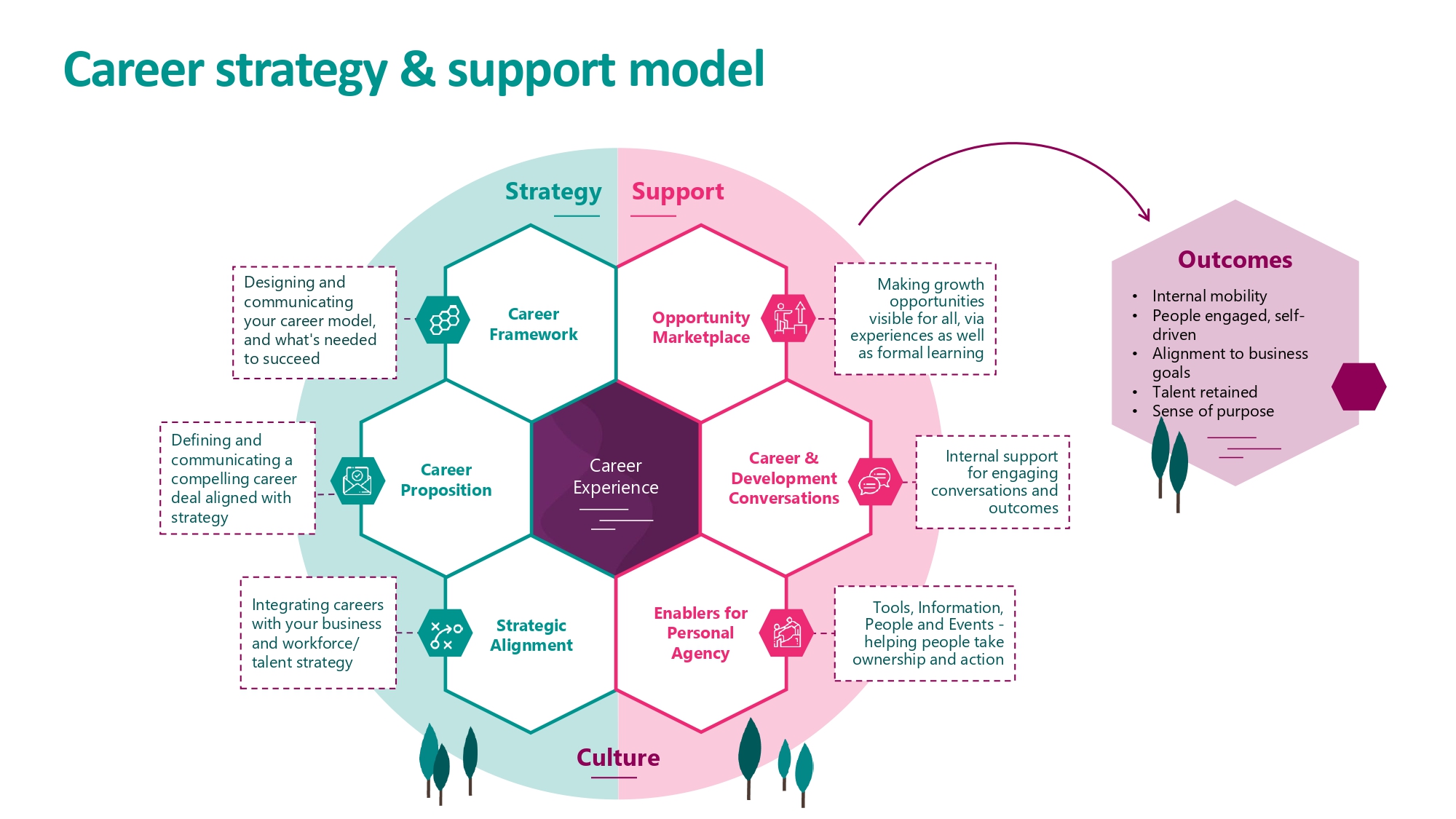How an explicit career development strategy equips individuals and organisations to have a sustainable future.
Rosemary McLean, Director at the Career Innovation Company, advocates the benefits of an explicit career development strategy to equip individuals and organisations to have a sustainable future.
The world of human resources has never been short of buzz words and prone to what some would say are fads. So, is the interest in careers a new fad?
The recent call for evidence based practice should be welcomed as organisations strive to focus on the things that will help them secure a positive future. Many organisations though, are struggling with how to navigate a fast-changing and unpredictable world, which requires a much more agile approach to future planning. The rise of automation and digitisation is accelerating, with a need to redefine work and what is needed to succeed. So the challenge is: How to take an evidence-based approach (avoiding the fads) while developing new ways of thinking that address unchartered territory? Careers work is certainly not a fad for me, it has been my life’s work.
I see that one consequence of the changes impacting organisations is the need for individuals to become more adaptable, able to upskill and navigate their own career journey in this turbulent context. At the same time organisations need to build capability and attract and retain employees, especially where key skills are scarce.
These two activities need to be aligned. It would seem obvious that an organisation’s people strategy in part addresses some of these challenges and brings competitive advantage, yet the voice of HR is still absent on many boards, and many HR practitioners have limited expertise in the area of careers.
Psychological contract at the heart
I would argue that the first thing a people strategy should do is address both the organisational needs and the needs of individual workers. This is not a new concept. Back in the 90s much was written on the psychological contract and a need for a new deal. Like now this was triggered by significant workplace changes; arising from organisational delayering, privatisation, the rise in globalisation and mergers and acquisitions. Many organisations at the time stepped up their efforts to provide career support and equip their employees with the skills to manage their own career. When the ‘War for Talent’ hit the business world in the late 90s the narrative changed to one dominated by top talent, and this has prevailed, leading to a career vacuum for many. Worker voice has also become reduced with the demise of unions. In their quest for increased productivity and creativity, organisations are starting to recognise the need to focus on an inclusive approach to talent management and attraction. They are seeing that ‘career’ is a central concept again, and some are also finding ways to strengthen the employee voice.
Is ‘career’ becoming the missing link for an effective future-focused people strategy?
Employers often have a well-developed talent management strategy, which addresses some of the key questions:
- Have we got the people with the skills we need for the future?
- What’s our leadership succession strength like?
- How healthy is the specialist talent pipeline?
- How diverse is our employee population?
- What’s the attrition rate, and are we losing people we want to keep?
Whilst all these are important questions they tend to view people as assets, and the increasing focus on metrics serves to reinforce that picture. It does little to connect with employees and how they see their future. Many organisations quite rightly are focusing on employee well-being, but this does not help them make the most of their talents, nor equip them to upskill and navigate their career.
Developing an intentional career development strategy
Turning back to evidence-based practice, there is much to justify a focus on career strategy as the key enabler to an effective talent and people strategy, and this isn’t new, just newly relevant! The AMO model formulated by Boxall and Purcell (2003) was originally developed to demonstrate that HR practices could lead to better individual and organisational performance. In this model, individuals perform well when they have:
- the ability (A) to perform (they can do the job because they have the necessary knowledge, skills and aptitudes);
- the motivation (M) to perform (they will do the job because they want to do it or feel they must do it); and
- the opportunity (O) to perform (their work structure and environment provide the necessary support and avenues for expression of ability and motivation).
All three dimensions of the AMO model connect with different aspects of career. Lack of perceived opportunity comes up time and again in employee surveys and is linked to employee attrition and dissatisfaction. One of the challenges related to opportunity is that it is increasingly harder for organisations to paint a picture of the future and what a career can look like. Ability and motivation are clearly connected when it comes to encouraging lifelong learning, and the need for upskilling. Shifting employee mindsets towards the need for self-directed learning is a key enabler to boost agility and productivity, as well as helping employees secure a sustainable future based on their personal employability.
What does an intentional career strategy involve?
In our Careers of Tomorrow research, we discovered that many organisations have pockets of well executed career development activities – such as annual careers weeks, in-house coaching, training in career conversations, and on-line career tools – offered on a tactical basis without alignment with other people processes. A strategic approach to career development starts with some fundamental questions:
- What will future careers need to be in this organisation? What skills, experiences and capabilities do we need to grow? What will the work be? Where will it take place?
- What are our underlying beliefs about careers in this organisation? Do we want to grow talent from within? Value specialists? Increase diversity? Buy in skills?
- What sort of careers can we articulate and provide to our employees and potential employees? What are the expectations and needs of our employees? What we will ‘give’ and what will we ‘get’? (Known as the Career Deal or Proposition.)
- What needs to change in the organisation to offer careers that align the needs of the organisation with employee aspirations for ‘good work’ and satisfying careers? How can we build the right mindsets and behaviours to deliver it?
These questions are at the heart of what will equip an organisation to adapt for the future, and in many ways involve redefining what career means in practice, with the employee’s experience firmly in mind.
Our experience of working with organisations at the strategic level involves addressing all aspects of activity and process that impact on the employee career experience. It starts with your strategy, with senior stakeholders exploring those fundamental careers questions, rather than jumping into tactical solutions which aren’t sustainable. Our Career Strategy and Support model provides a coherent framework for identifying what work needs to be done and how it addresses your organisation’s future skill needs and priorities.
In this disrupted world we’d say it’s about humanising the workplace – not a fad!- and recognising that everyone has potential to be unlocked.
Find out how organisations are embedding their career proposition, developing talent and supporting diverse career stages at our virtual roundtables.






